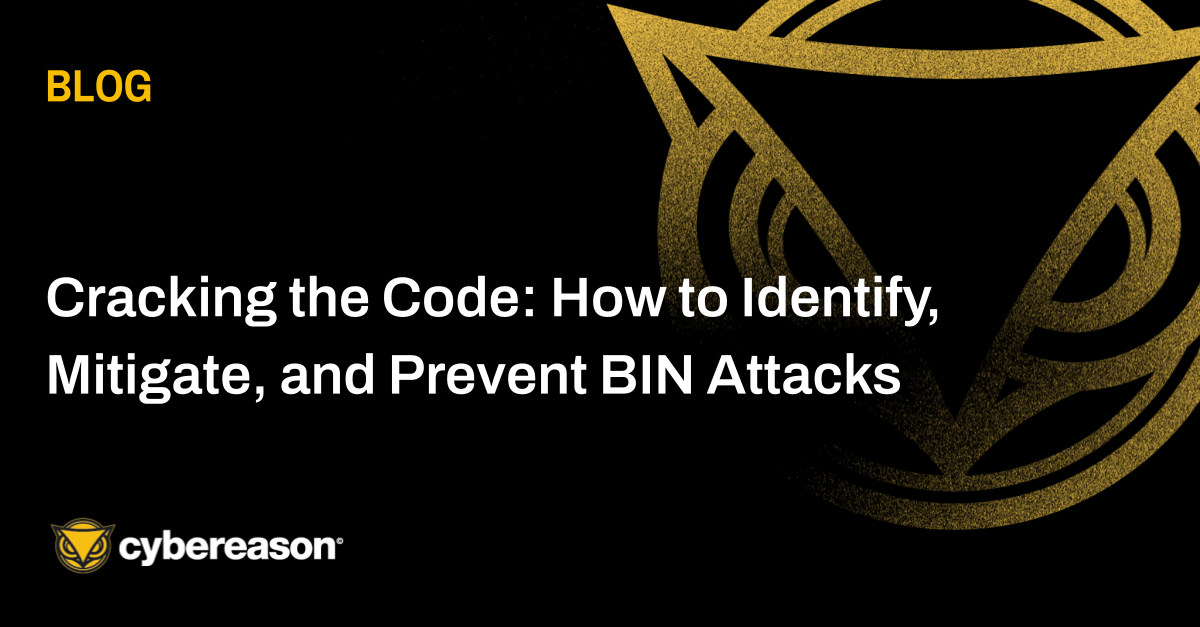
Your Data Is Under New Lummanagement: The Rise of LummaStealer
In this Threat Analysis report, Cybereason investigates the rising activity of the malware LummaStealer.

Cybereason Consulting Team
Threat actors with financial motivations often leverage BIN attacks when targeting financial services or eCommerce victims. BIN attacks involve threat actors systematically testing card numbers stemming from a Bank Identification Number (BIN) to find valid card details. BIN values are assigned to card issuers and form the first 6-8 digits on payment cards. These values are published to merchants, payment processors, and other service providers to facilitate transactions and are publicly available. The BIN is then followed by an additional set of numbers (the account number) to form a complete Primary Account Number (PAN), or card number.
Threat actors often exploit the first 6–8 known digits of a credit or debit card (the BIN) to systematically generate remaining account numbers in hope of finding valid card numbers.These attacks aim to identify valid card details for fraudulent transactions and are examples of organized & eCrime threat actor groups who are financially motivated. Generated values can include CVVs, expiry dates, and postal codes. This attack is considered a form of brute-force enumeration.
In order to identify and effectively mitigate a BIN attack, it’s crucial to be able to identify elements of a BIN attack in progress. Threat actors often test large volumes of card numbers, leading to patterns of failed authorization attempts. By monitoring transaction logs and collaborating with payment processors, organizations can pinpoint if their BINs are being targeted. Doing so requires configuration of a log aggregation and monitoring setup that allows for ingestion of transaction logs and the ability to flag when unusual volumes of failed authorization attempts are occurring.
One of the simplest and most effective strategies to defend against BIN attacks is the implementation of rate limiting. This technique restricts the number of requests a single IP address or device can make within a specific time frame, significantly hindering automated systems designed to test multiple card numbers in rapid succession. By limiting the speed and frequency of these requests, businesses can reduce the effectiveness of brute-force enumeration attempts. This foundational defense is not only easy to implement but also serves as a critical layer in a broader security strategy.
Enhanced authentication measures further fortify defenses against BIN attacks by verifying that interactions are initiated by humans rather than bots. CAPTCHA and multifactor authentication (MFA) are essential tools that prevent automated scripts from exploiting vulnerabilities in online payment systems. For higher-risk transactions, organizations should enforce stricter verification processes such as 3D Secure protocols (e.g., Verified by Visa or Mastercard SecureCode). These measures not only deter automated attacks but also instill confidence in customers by ensuring that payment forms and processes are secure. Combining these authentication layers creates a significant barrier for attackers attempting to exploit BIN-related vulnerabilities.
Blocking suspicious traffic is another vital component of an effective security strategy. Web Application Firewalls (WAFs) can identify and block malicious traffic, such as repeated failed payment attempts or activity originating from known malicious IP addresses. Geofencing can offer a limited additional layer of protection by restricting or outright denying traffic from regions with historically high levels of fraudulent activity or countries outside the organization’s customer base. Geofencing alone is not foolproof, as modern VPN solutions allow attackers to circumvent geographic restrictions. A holistic approach that combines WAFs, geofencing, and other traffic analysis tools can significantly reduce exposure to brute-force and scripted attacks.
Advanced fraud detection tools powered by machine learning and device fingerprinting are essential for identifying and mitigating unusual transaction patterns. These systems analyze flagged activities in real-time, comparing them against global databases of compromised cards to preempt fraudulent transactions. Pairing anomaly detection with real-time transaction scoring and device fingerprinting enhances an organization’s ability to respond to potential threats proactively. By deploying these tools, businesses can not only identify suspicious activity but also take immediate reactive measures to prevent further exploitation. This proactive approach ensures that threats are detected and mitigated before significant damage occurs.
Effective communication and collaboration with stakeholders are critical during a BIN attack. Organizations should consider proactive notification to card issuers associated with targeted BINs, enabling them to freeze compromised cards and monitor for related fraudulent activity. Additionally, keeping clients and affected parties informed builds trust and ensures that those impacted understand how to protect themselves. Providing customers with guidance on monitoring their accounts for unauthorized transactions further strengthens the organization’s response. Transparency and timely communication not only mitigate the immediate impact of an attack but also demonstrate a commitment to safeguarding customer interests.
Strengthening system security forms the foundation of any robust defense against BIN attacks. Regularly reviewing and updating payment processing systems helps eliminate vulnerabilities that attackers might exploit. Addressing outdated software, misconfigurations, and other weaknesses ensures a resilient infrastructure. Organizations should also ensure that all systems are patched and updated to close potential security gaps. By maintaining a secure and up-to-date environment, businesses reduce the likelihood of successful attacks and create a stronger defense against evolving threats.
When a BIN attack suggests broader fraud activity, engaging digital forensics and incident response teams is essential. These experts can analyze logs, trace attackers’ methods, and recommend strategies to prevent recurrence. Collaboration with law enforcement and payment networks may also be necessary to address the larger implications of the attack. Coordinating an effective incident response ensures not only the mitigation of current threats but also the implementation of measures to strengthen long-term resilience.
Long-term measures are equally important in preventing BIN attacks and enhancing overall security. Tokenization, for instance, replaces sensitive card details with unique tokens that cannot be exploited in the same way as BIN data, minimizing attackers’ success rates. Compliance with Payment Card Industry Data Security Standards (PCI DSS) ensures adherence to best practices for payment processing security. Behavioral analysis tools can identify suspicious user behaviors, such as repetitive card number entry attempts, while BIN range monitoring can trigger alerts for unusual activity associated with specific BIN ranges (e.g., patterns in attempts or sequential number attempts). Together, these measures create a framework for detection and prevention.
Key Recommendations:
Our experts compiled a list of recommendations to help protect your organization against these type of threats:

In this Threat Analysis report, Cybereason investigates the rising activity of the malware LummaStealer.
.png)
In this Threat Analysis Report, investigates the flow of a Tangerine Turkey campaign

In this Threat Analysis report, Cybereason investigates the rising activity of the malware LummaStealer.
.png)
In this Threat Analysis Report, investigates the flow of a Tangerine Turkey campaign
Get the latest research, expert insights, and security industry news.
Subscribe